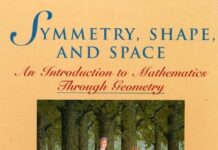
Ebook Info
- Published: 2012
- Number of pages: 296 pages
- Format: PDF
- File Size: 8.08 MB
- Authors: L.Christine Kinsey
Description
This book aims to provide undergraduates with an understanding of geometric topology. Topics covered include a sampling from point-set, geometric, and algebraic topology. The presentation is pragmatic, avoiding the famous pedagogical method “whereby one begins with the general and proceeds to the particular only after the student is too confused to understand it.” Exercises are an integral part of the text. Students taking the course should have some knowledge of linear algebra. An appendix provides a brief survey of the necessary background of group theory.
User’s Reviews
Reviews from Amazon users which were colected at the time this book was published on the website:
⭐Let me begin by saying that I only got through the chapter on triangulations. I used this book in an undergraduate topology course where the instructor was not the best at teaching topology. So, I had to self-study with this book.The first three chapters of the book are very well written. The theorems are proven in an intuitive manner that makes sense with some analysis background. Also, the exercises encourage, and at times force, the reader to really understand the topologies of the reals. The reader then is introduced to general topological spaces, including quotient and product topologies. This material is also very well written and relatively easy to understand, with some work by the reader.The chapter on triangulations and surfaces is very difficult to understand. In the first few chapters, I could tell that the casual language chosen by the author would eventually lead to trouble. The careful word choices necessary in a math book were missing in this chapter. Little details like “relative to” and “in” are left out, sometimes requiring hours of careful reading of definitions trying to figure out exactly what the author means. This, to me, in unacceptable. The book reads more like lecture notes and less like a text book. Fortunately, I also purchased Munkres’ topology book and referred to that whenever I didn’t understand the author’s explanation, which was a lot in the last chapter I studied.Taking into account all the deficiencies with this book, I would still recommend it just for the first 3 chapters. These chapters are an excelent introduction to topology. I give this book 4 stars because it offers a good introduction to general topology. I also liked how the author put the exercises in the sections. This made it easy to see exactly what you should try to use in your proofs. I would also getting another, more theoretical, book to use as a reference if(when?) you get stuck by the author’s poor choice of words.
⭐I don’t like print on demand books, I wish they return to traditional offset printing.
⭐I have used this book a couple of times as a required textbook for a course in introductory algebraic topology. Overall, a good book. Good exposition and plenty of exercises, with just a few complaints. Both the good and the bad inspired me in writing my own book,
⭐. My impressions, from back then, are below. Chapter 1, Introduction to topology: I wished for even more applied stuff here, especially applications and ideas outside mathematics. Chapter 2, Point-set topology in R^n: I was looking for a clearer connection to calculus here, beyond just the definition of continuity: continuity under algebraic operations, the Intermediate Value Theorem, sequences, etc. Chapter 3, Point-set topology is quite short, as it should be. Chapter 4, Surfaces: The definition of a “regular complex” is bad and I don’t think it can be fixed. I understand that in such a book compromises are inevitable, but a simplified version of a CW-complex would be more appropriate. Meanwhile, dealing with the full proof of the Classification Theorem of Surfaces didn’t fit the purpose I had for the book. Chapter 5, The euler characteristic: It is appropriately introduced as the very first topological invariant — of graphs and surfaces — and a lead into homology. Chapter 6, Homology: A first encounter with homology should be gentler in my opinion, holding the algebra back for a while. Meanwhile, the proof of the theorem about the homology of oriented surfaces lacks some details. Error: on page 139, the “cone” of the circle isn’t the sphere but the “suspension” is. Chapter 7, Cellular functions: I wished for more examples of specific functions: inclusions, projections, quotients, etc. Chapter 8, Invariance of homology: that and the Simplicial Approximation Theorem require proofs that are quite challenging for such a course. Chapter 9, Homotopy: For such a topic, too few pictures here. Chapter 10, Miscellany: Good stuff here: the Jordan Curve Theorem, 3-manifolds, etc., but too little time… Chapter 11, Topology and calculus: More good stuff (even though the presentation is a bit sketchy): vector fields, ODEs, differentiable manifolds, etc.
⭐After a promising start the exposition tends to become loose in placesand crucial steps are skipped in some of the proofs. In particular, thetreatment of winding numbers is incomplete as it stands.The final section – a blitz through differential forms – is nothing but anunsightly barrage of formulas designed to bewilder the uninitiated.
⭐Considering several other undergrad topology texts, e.g. Munkres, Armstrong, etc. this is the easiest to work with. Certainly the best text for self-study. The problems are not too difficult yet they help you grasp concepts as well. They are also laid out as you go; so every so often while you read the text you encounter a problem and you do it as you go. It is much better than putting them in the back of the chapters, as most text do. It is better to lay the problems in the text so you are encouraged to do them as you learn the material. The material in the text is very well explained and contrary to the previous review, is very well-suited, and with sufficient rigor, for mathematics students. The fact that this book “can be grasped at the sophomore level” as the previous revewer claims (and I agree with) lends credence to the simplicity of presentation of the material. Some reviewers I suppose aren’t satisfied unless they see a hyperdense conglomeration of gobbledygook which characterizes so many mathematics texts. I don’t fall into that camp and if you don’t either and at the same want to begin study in topology then I highly recommend this book.
⭐I must say that this is by far the best topology text that I have seen. Very readable, easy to follow. The anecdotal comments are also amusing. I’m particularly fond of the Ham and Cheese Sandwich Theorem! Highly recommend.
Keywords
Free Download Topology of Surfaces (Undergraduate Texts in Mathematics) in PDF format
Topology of Surfaces (Undergraduate Texts in Mathematics) PDF Free Download
Download Topology of Surfaces (Undergraduate Texts in Mathematics) 2012 PDF Free
Topology of Surfaces (Undergraduate Texts in Mathematics) 2012 PDF Free Download
Download Topology of Surfaces (Undergraduate Texts in Mathematics) PDF
Free Download Ebook Topology of Surfaces (Undergraduate Texts in Mathematics)

